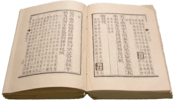Literary genre
| Literature |
|---|
 |
| Major forms |
| Genres |
| Media |
| Techniques |
| History and lists |
| Discussion |
|
|
A literary genre is a category of literary composition. Genres may be determined by literary technique, tone, content, or even (as in the case of fiction) length. The distinctions between genres and categories are flexible and loosely defined, often with subgroups.
The most general genres in literature are (in loose chronological order) epic, tragedy,[1] comedy, and creative nonfiction. They can all be in the form of prose or poetry. Additionally, a genre such as satire, allegory or pastoral might appear in any of the above, not only as a subgenre (see below), but as a mixture of genres. Finally, they are defined by the general cultural movement of the historical period in which they were composed.
Genre should not be confused with age categories, by which literature may be classified as either adult, young adult, or children's. They are also not the same as format, such as graphic novel or picture book.
Genres

Just as there are different types of painting: landscape, still life, portrait; there are different types of literary works. These types tend to share specific characteristics. Genres describe those works which share specific conventions.[2]
Genres are often divided into subgenres. Literature is divided into the classic three forms of Ancient Greece, poetry, drama, and prose. Poetry may then be subdivided into the genres of lyric, epic, and dramatic. The lyric includes all the shorter forms of poetry, e.g., song, ode, ballad, elegy, sonnet.[2] Dramatic poetry might include comedy, tragedy, melodrama, and mixtures like tragicomedy.
The standard division of drama into tragedy and comedy derives from Greek drama.[2] This parsing into subgenres can continue: comedy has its own subgenres, including, for example, comedy of manners, sentimental comedy, burlesque comedy, and satirical comedy.
Often, the criteria used to divide up works into genres are not consistent, and may change constantly, and be subject of argument, change and challenge by both authors and critics. However, even a very loose term like fiction ("literature created from the imagination, not presented as fact, though it may be based on a true story or situation") is not universally applied to all fictitious literature, but instead is typically restricted to the use for novel, short story, and novella, but not fables, and is also usually a prose text. Types of fiction genres are science fiction and fantasy, historical fiction, realistic fiction and mysteries.
Semi-fiction spans stories that include a substantial amount of non-fiction. It may be the retelling of a true story with only the names changed. The other way around, semi-fiction may also involve fictional events with a semi-fictional character, such as Jerry Seinfeld.
Genres may easily be confused with literary techniques, but, though only loosely defined, they are not the same; examples are parody, frame story, constrained writing, stream of consciousness.
Major forms
See also
Notes
References
- Bakhtin, Mikhail M. (1983). "Epic and Novel". In Holquist, Michael. The Dialogic Imagination: Four Essays. Austin: University of Texas Press. ISBN 0-292-71527-7.
- Derrida, Jacques; Ronell, Avital (Autumn 1980). "On Narrative: The Law of Genre" (PDF). Critical Inquiry. The University of Chicago Press. 7 (1): 55–81. doi:10.1086/448088.
- Dorst, John D. (Oct–Dec 1983). "Neck-Riddle as a Dialogue off Genres: Applying Bakhtin's Genre Theory". Journal of American Folklore. 96 (382): 413–433. JSTOR 540982.
External links
| Library resources about Literary genre |